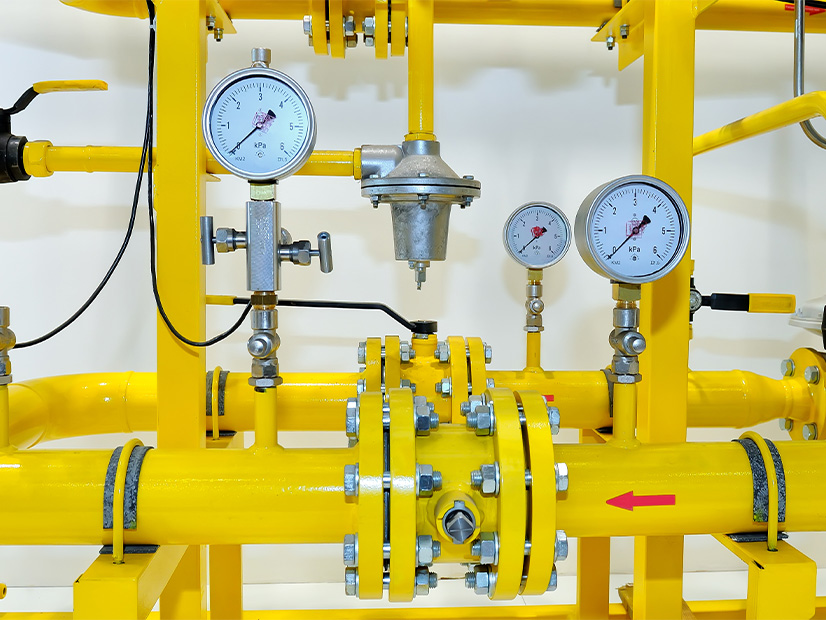
A study commissioned by the California Public Utilities Commission has found that injecting more than small amounts of hydrogen into natural gas pipelines can increase leakage and degrade metal, raising questions about the safety of using existing gas infrastructure for decarbonization.
Advocates have suggested that blending higher amounts of renewably produced “green” hydrogen with natural gas could be a way to partially reduce the gas system’s carbon footprint while retaining the value of existing gas infrastructure. State lawmakers have expressed interest in the concept, with bills directing state energy agencies including the CPUC to study hydrogen’s potential.
As part of that effort, researchers at University of California, Riverside conducted a “Hydrogen Blending Impacts Study,” which the CPUC commissioned as part of its long-running rulemaking on renewable natural gas. Part four of that rulemaking, opened in November 2019, addresses standards for injection of renewable hydrogen into gas pipelines.
“This study provides additional insight into the possibilities and limits of California’s pipeline infrastructure as we explore options for supplying zero-carbon energy to hard-to-decarbonize applications,” CPUC Commissioner Clifford Rechtschaffen, the lead commissioner in the rulemaking, said in a July 21 news release accompanying the study’s release.
The 180-page study assessed operational and safety concerns related to injecting hydrogen into the existing natural gas pipelines at varied percentages.
The researchers found that hydrogen blends of up to 5% in the natural gas stream are relatively safe but that blending more hydrogen in gas pipelines can embrittle steel pipes and raise the risk of leaks.
“A primary concern of hydrogen blending with respect to pipeline durability and integrity arises from a hydrogen embrittlement phenomenon observed in many metals,” the study said. “Hydrogen embrittlement is defined as the process of strength and ductility reduction within a metal due to hydrogen induced damage, which makes it more brittle. Main mechanical properties of steel such as tensile strength, toughness and fatigue resistance are adversely affected by hydrogen embrittlement.”
Hydrogen blends above 5% could require modifications to gas appliances such as stoves and water heaters to avoid leaks and malfunctions, it said.
“This systemwide blending injection scenario becomes concerning as hydrogen blending approaches 5% by volume,” the study said. “As the percentage of hydrogen increases, end-use appliances may require modifications, vintage materials may experience increased susceptibility and legacy components and procedures may be at increased risk of hydrogen effects.”
Hydrogen blends of more than 20% carry a higher risk of permeating plastic pipes, increasing the risk of ignition outside the pipeline, the CPUC noted.
Plastics such as polyethylene “make up more than half of the pipe materials used in the natural gas distribution system,” the study said. Unlike steel, prior reports showed “no degradation [to plastics] by pure hydrogen … and little or no interaction between hydrogen gas and polyethylene.”
“The main concern with pipelines comprising of polyethylene is permeability to hydrogen, which may result in leakage of gaseous hydrogen,” it said.
About 65% of distribution pipelines are made of plastics and 35% are steel, it said.
Another concern identified by the study is that hydrogen has a lower energy content than methane and other natural-gas components, requiring more hydrogen-blended gas to produce the same amount of energy.
The study called for additional examination of hydrogen blending to ensure its safety, including demonstration projects under controlled, real world circumstances.
“As there are knowledge gaps in several areas, including those that cannot be addressed through modeling or laboratory scale experimental work, it is critical to conduct real world demonstration of hydrogen blending under safe and controlled conditions,” the study said.
The CPUC requested public comment on the study by Aug. 26.
“I look forward to party comments on hydrogen-methane blending and its role in decarbonization strategies,” Rechtschaffen said.


